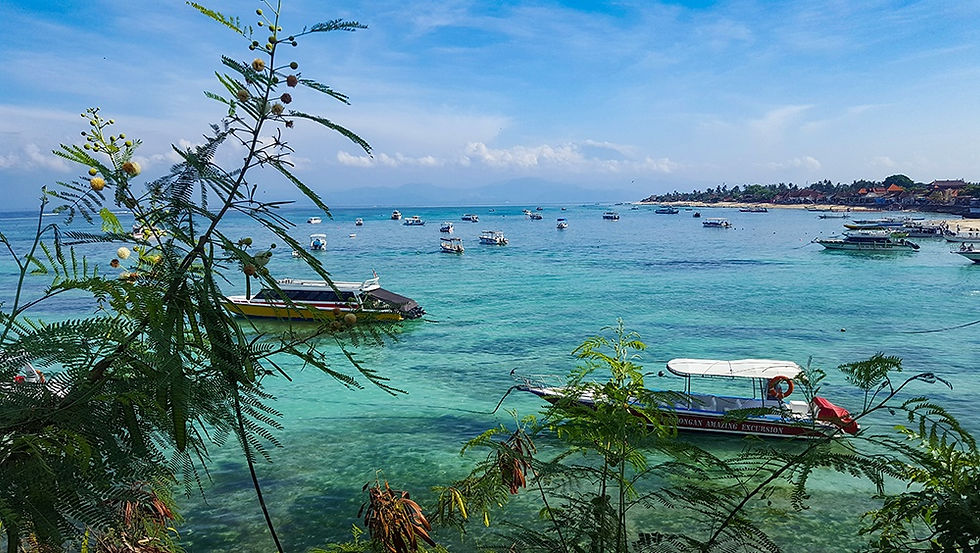Nusa Lembongan - Bali’s Sister Island
- Shannon
- Sep 12
- 4 min read
An Island Shaped by Legends and Tides
Just 12 kilometres off the southeast coast of Bali lies Nusa Lembongan, a compact gem in a trio of islands that make up part of the Lesser Sunda chain, born from volcanic origins. Though it spans only 8 square km's, the island is a place of striking contrasts and natural beauty. Bright coral reefs encircle the island, while soft white beaches and weathered limestone cliffs shape its edges. To the northeast, a 212 hectare mangrove forest spreads out in dense, tangled silence, its shadowed waterways a stark contrast to the island’s bright sands and the wide open sea.

Jungutbatu Beach is the main port for visitors from Bali
According to Balinese legend, Nusa Lembongan rose from the ocean sometime around 175 AD when a powerful necromancer named I Renggan was exiled from Bali after being cursed during a spiritual feud with the Raja of Mount Agung. He sailed into the seas in fury and in a final act of defiance, he shattered his sacred boat. Where its sail fell, the ocean split, creating the narrow strait between what would become Nusa Ceningan and Nusa Lembongan. Ancient navigation charts are since said to show the group of islands marked with a skull and crossbones, a clear warning to sailors that under no circumstances should they dare harbour their ships near the islands’ shores.
It is believed that Nusa Penida, Nusa Lembongan and Nusa Ceningan once formed their own small kingdom, independent from Bali’s central powers. By the late 1600's however, this triad of islands was transformed into a remote penal colony, an Asian Alcatraz. Rebels, criminals and those considered politically dangerous were exiled here, out of sight and out of mind. This geographic isolation, paired with a population of outcasts and mystics, became fertile ground for the development of Leyak (pronounced “lay-ak”), a dark and esoteric form of Balinese black magic. Practitioners were said to possess the ability to transform into animals, commune with spirits, and manipulate the physical world through ancient rites and offerings. While leak existed in Bali proper, it became far more potent and feared on Nusa Penida and its sister islands, where secrecy and solitude allowed it to evolve into something even the mainland priests dared not challenge.

Over time, whispers of this sorcery spread across the Bali Sea. Nusa Penida in particular, became known as the dwelling place of malevolent spirits and powerful sorcerers, feared even by high-caste Brahmins. The Balinese would make ceremonial offerings facing the southeast, toward the islands, to appease the dark forces believed to reside there. Ritual dances like the Barong and Rangda stem from this tension between good and evil and to this day, Nusa Penida is seen as a kind of spiritual frontier. Eventually, as exile practices faded and the islands were left to govern themselves, their fearsome reputation remained. For generations, the people of Bali approached the Nusa islands with a mixture of reverence and dread, believing them to be the threshold between the physical world and the supernatural.

Marine conservation plays a vital role in preserving the natural beauty and ecological balance of Nusa Lembongan, an effort that is not only essential for the environment but also for the island’s long term tourism sustainability. In 2009, The Nature Conservancy and the Coral Triangle Initiative established a community centre on the island, aimed at educating locals and visitors about the fragile marine ecosystems surrounding the Nusa islands. Conservation efforts include coral reef monitoring, sustainable diving practices and the protection of marine megafauna. One notable project is the Olive Ridley Turtle release program, based near Sunset Beach, which gives critically endangered hatchlings a fighting chance at survival in the open ocean.
The waters surrounding Nusa Lembongan are considered some of the healthiest in Indonesia, with well preserved coral reefs that support a wide variety of marine life. Species commonly observed include reef fish, manta rays, sunfish and green sea turtles, particularly in designated marine protected areas. In addition to conservation and tourism, seaweed farming remains a key part of the local economy. Farmers cultivate seaweed in shallow coastal areas during low tide, drying it on racks before it is sold, mostly for use in food additives, cosmetics and industrial products. The combination of conservation efforts and traditional livelihoods reflects a practical balance between ecological preservation and economic necessity on the island.
🗺️ Location
Jungutbatu, Nusapenida, Klungkung Regency, Malay Archipelago, Indonesia
🚆 How to get there
The Island is served by regular direct speed-boat services, mostly from the coastal resort of Sanur. Crossing time is approximately 30-40 minutes and services run at regular intervals during daylight hours. There is no main pier and getting off the boat requires walking into the water up to your thighs. Depending on the ticket you book, it can include pickup at your accommodation in Bali and drop off in Lembongan. Return transfers cost around $50 USD per person but prices can vary based on the season, operator and additional services included. Haggle!
⭐ Attraction Info
Populated by very few cars, the main source of transportation is by scooter, pushbike or by foot. The island offers a well-developed range of visitor facilities, including a wide selection of hotels, boutique resorts and homestays, many of which are perched above the cliffs or set along the beachfront. The island also has a solid dining scene, with everything from casual warungs to stylish restaurants serving Indonesian and international cuisine. While it's quieter and more laid-back than mainland Bali, prices for accommodation and food tend to be slightly higher, reflecting the island’s smaller scale and reliance on boat transport for supplies.
🔗Tourist Website

Thanks for reading about Nusa Lembongan - Bali’s Sister Island. Check out more awesome destinations here!
Nusa Lembongan, often called Bali’s Sister Island, is a tranquil escape just a short boat ride away





















